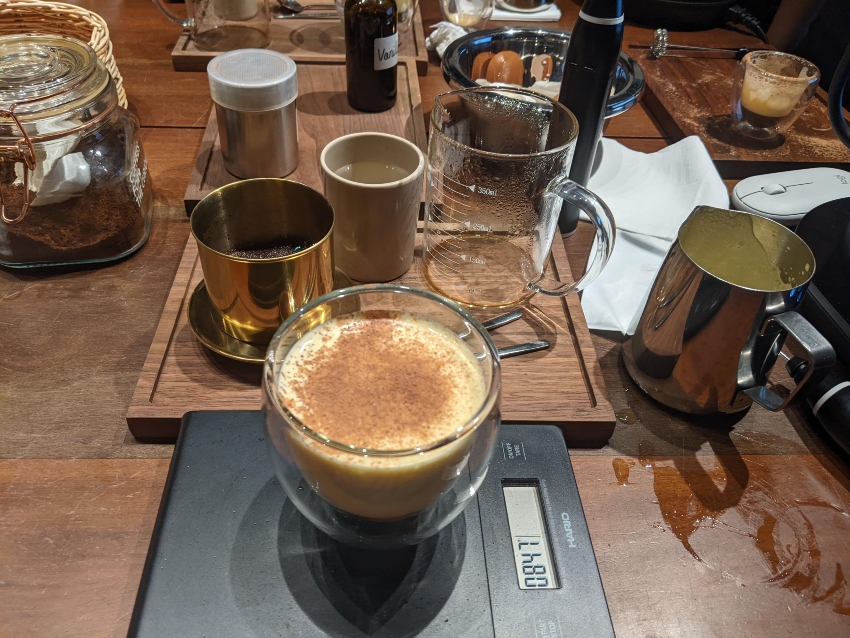The first morning at my Saigon hostel, I headed downstairs at my usual 5:30 am and was surprised to encounter someone else there. Dave is my age and recently retired from a career as a firefighter. I was impressed to learn that he could survive on his pension, and he replied, “I can if I live here” He plans to go back to the UK for a couple months each summer but seems perfectly comfortable relaxing in Asia after a demanding career.
We chatted for awhile before I asked him if he’d be interested in taking a break from his retirement to attend a coffee making glass with me. I’d visited a coffee plantation in Mexico and worked as a barista in San Francisco for a couple years, but Vietnam takes coffee to a new level.
I’d signed up for an AirBnB experience to make something called egg coffee. Dave was game, so I added him to my reservation, and we headed out the next morning to our class. Getting there presented a few challenges. The first was crossing one of the busiest streets in Saigon.

While there are stop signals, they are specific to vehicle traffic. There aren’t crosswalk lights, cross walks, or any right of way granted to the pedestrian. The best you can hope for is that the throng of motorbikes will weave around you.
The expectation once you leave the sidewalk is that you cannot stop, change speed, or turn around. You are responsible for making your way across the street at a steady pace. As long as you follow those rules, everyone will adjust to avoid you. It’s not a right but a courtesy, and in a way exemplifies the way everyone works together in this communal society. No one has special rights, and everyone works together.
The next challenge was finding the coffee shop. What Google maps led us to appeared to be a storage garage. Had it not been for a sign hanging next to the entrance, we would not have ventured inside. What we found at the top of the stairs was completely unexpected.

Lacaph is a beautiful two story coffee shop that makes a science out of coffee production. After checking in at the reception desk, we were led to the coffee shop side of the business. This is the waiting area for those who are signed up for a class or those who just want to get a cup of coffee.
Knowing I’d be drinking coffee during the class I declined to order one at the bar, but I did find it impossible to pass up a beautiful gelatin dessert in the display case. While I didn’t really enjoy the texture, the flavors were delightfully subtle, and you couldn’t help but be impressed by the presentation.

Before I could finish my snack, our instructor came to tell us it was time to head upstairs to class. I figured I could finish it in the classroom, but when we got there, I couldn’t find a single space on the workbench to place it.
The table reminded me of the chemistry lab in highschool. It was filled with scales, beakers, and other tools. It generated a sense of excitement that this was to be a serious educational session. On the projection screen above the table were images of how the tools would be utilized. Our instructor began by explaining “why egg coffee?”

It turns out that when the French colonized Vietnam, they brought many of their home comforts like wine, the baguette and coffee. While these can be produced in Vietnam, the one thing there isn’t a lot of are cows. It’s the reason you don’t find much dairy in Asian foods or the Asian diet. Originally, milk was very expensive so only the rich could enjoy a cappuccino or latte.
One ingenious entrepreneur devised a way to resolve the problem. Something Asia does have a lot of is chickens. He figured out if you whipped an egg to just the right consistency, you could use it to replace the foam on top of a cappuccino. And that is what we learned to do in our class.
First we brewed the coffee. The process included pouring the coffee grounds into the microfilter and then adding just enough water to cover them. After blooming the grounds for a minute, we added the rest of the water and allowed the coffee to drip into the cup below for about five minutes.

While the coffee was brewing, we made the egg mixture. Into a measuring cup, we added two egg yolks, a pinch of salt, honey and vanilla to taste. We used a milk frother to agitate the mixture for about five minutes until it had the consistency of light foam. By the time we’d made the foam, the coffee was ready.
We removed the filter from the coffee cup, poured the egg mixture on top, and added a pinch of cinnamon for taste. What we were left with was egg coffee that had the rich taste of custard and the light appearance of a cappuccino.


